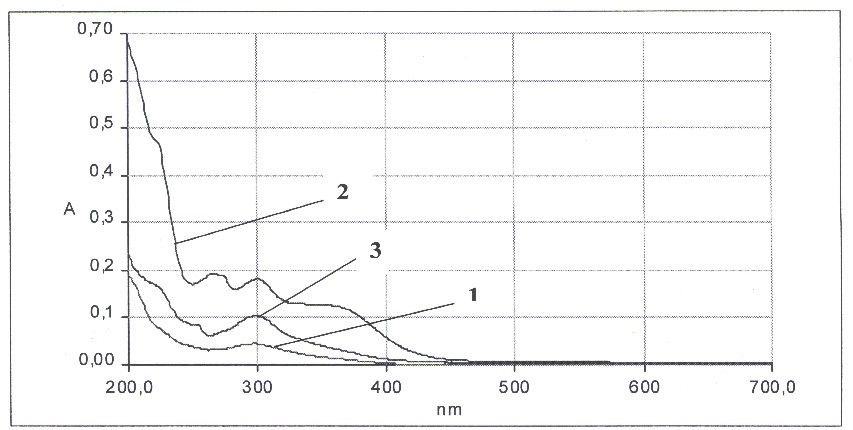INHIBITION OF PHOSPHATIDYLCHOLINE LIPOSOMES OXIDATION BY PHENOLIC COMPOUNDS OF ALOE EXTRACTS: A. ARBORESCENS, A. PILLANSII AND A. SQUARROSA
Abstract
Various species of the genus Aloe which there are in the world more than 500 are considered as important sources of biologically active substances and attract an attention of researchers by numerous manifestations of their biological properties. The most studied and used Aloe species are A. arborescens and A. vera, however some other species show not smaller biological activity, in particular antioxidant, than made mention. In the present work on model of the initiated oxidation of phosphatidylcholine liposomes comparison of the antioxidant activity (AOA) of leaves extracts of A. arborescens, A. pillansii, A. squarrosa and also the total content of their phenolic compounds was carried out. It is established that A. pillansii extract has approximately by 12 times higher AOA, than A. arborescens extract, and by 4 times, than A. squarrosa. The measured values of the total phenolic compounds content showed considerably smaller difference between these extracts. It can demonstrate existence in A. pillansii leaves of more difficult antioxidant profile, than in A. arborescens, and higher concentration of active phenolic metabolites. Results of this work allow recommending A. pillansii for more depth studies of its different biological activities.
Downloads
Metrics
References
Salehi B., Albayrak S., Antolak H., Kręgiel D., Pawlikowska E., Sharifi-Rad M., Uprety Y., Tsouh Fokou P.V., Yousef Z., Amiruddin Zakaria Z., Varoni E.M., Sharopov F., Martins N., Iriti M., Sharifi-Rad J. International Journal Molecular Sciences, 2018, vol. 19, p. 2843, DOI: 10.3390/ijms19092843.
Sazhina H.H., Lapshin P.V., Zagoskina N.V., Misin V.M. Khimiya rastitel'nogo syr'ya, 2015, no. 2, pp. 169–176, DOI: 10.14258/jcprm.201502527. (in Russ.).
McClements D.J. Nanoparticle- and Microparticle-based delivery systems: Encapsulation, protection and release of active compounds. CRC Press Taylor and Francis Group. New York, 2014, pp. 548–620.
Thomas A.H., Catala A., Vignoni M. Biochimica and Biophysica Acta, 2016, vol. 1858, pp. 139–145, DOI: 10.1016/jbbamem.2015.11.002.
Mosca M., Cerlie A., Ambrosone L. Chemistry and Physics of Lipids, 2011, vol. 164, pp. 158–165, DOI: 10.1016/j.chemphyslip.2010.12.006.
Palmina N.P., Maltseva E.L., Chasovskaya T.E., Kasparov V.V., Bogdanova N.G., Menshov V.A., Trofimov A.V. Australian Journal of Chemistry, 2014, vol. 67, pp. 858–866, DOI: 10.1071/CH13663.
Altunkaya A., Gokmen V., Skibsted L.H. Food Chemistry, 2016, vol. 190, pp. 25–32, DOI: 10.1016/j.foodchem.2015.63.069.
Lokhmatikov A.V., Voskoboynikova N., Cherepanov D.A., Skulachev M.V., Steihoff H.J., Skulachev V.P., Ar-men Y., Mulkidjanian A.Y. Oxidative Medicine and Cellular Longevity, 2016, vol. 1, pp. 1–19, DOI: 10.1155/2016/8679469.
Kuznetsova N., Kandyba A., Vostrov V., Kadykov V., Gaenko G., Vodovozova E. Journal of Drug Delivery Science Technology, 2009, vol. 19, no. 1, pp. 51–59, DOI: 10.1016/S1773-2247(09)50007-X.
Semenova M.G., Antipova A.S., Misharina T.A., Alinkina E.S., Zelikina D.V., Martirosova E.I., Palmina N.P., Binyu-kov V.I., Maltseva E.L., Kasparov V.V., Ozerova N.S., Shumilina E.A., Baeva K.A., Bogdanova N.G. Role of the co-valent conjugate (sodium caseinate + maltodextrin) and a plant antioxidant in the protection against oxidation of the composite food ingredients, containing the equimass amount of w-3 and w-6 polyunsaturated fatty acids. Gums and Stabilisers for the Food Industry 18: Hydrocolloid Functionality for Affordable and Sustainable Global Food Solutions. Cambridge. Publ.: Royal Society of Chemistry, 2016, pp. 182–189.
Sazhina N.N., Antipova A.S., Semenova M.G., Palmina N.P. Russian Journal of Bioorganic Chemistry, 2019, vol. 45, no. 1, pp. 34–41, DOI: 10.1134/S1068162019010138.
Zaprometov M.N. Fenol'nyye soyedineniya i metody ikh issledovaniya. Biokhimicheskiye metody v fiziologii rasteniy. [Phenolic compounds and methods for their study. Biochemical methods in plant physiology]. Moscow, 1971, pp. 185–197. (in Russ.).
Gutterman Y., Chauser-Volfson E. Biochemical Systematics and Ecology, 2000, vol. 28, no. 9, pp. 825–838.
Olennikov D.N., Zilfikarov I.N., Ibragimov T.A. Khimiya rastitel'nogo syr'ya, 2010, no. 3, pp. 77–82. (in Russ.).
Lucinia L., Pellizzonia M., Pellegrinob R., Molinaria G.P., Collac G. Food Chemistry, 2015, vol. 170, pp. 501–507. DOI: 10.1016/j.foodchem.2014.08.034.
Olennikov D.N., Zilfikarov I.N., Ibragimov T.A., Toropova A.A., Tankhayeva L.M. Khimiya rastitel'nogo syr'ya, 2010, no. 3, pp. 83–90. (in Russ.).
McPherson P.A.C., Bole A., Cruz K.A., Young I.S., McEneny J. Chemistry and Physics of Lipids, 2012, vol. 165, pp. 682–688, DOI: 10.1016/j.chemphyslip.2012.07.004.
Derffel' K. Statistika v analiticheskoy khimii. [Statistics in analytical chemistry]. Moscow, 1994, 268 p. (in Russ.).
Seyoum A., Asres K., El-Fiky F.K. Phytochemistry, 2006, vol. 67, pp. 2058–2070, DOI: 10.4236/ns.2018.104014.
Hu H., Hu X., Qiuhui H. Journal of Agricultural and Food Chemistry, 2003, vol. 51, pp. 7788–7791, DOI: 10.1021/jf034255i.
Huang D., Ou B., Hampsch-Woodil M., Flanagan J., Prior R. Journal of Agricultural and Food Chemistry, 2002, vol. 50, pp. 4437–4444, DOI: 10.1021/jf0201529.
Lee S., Do S.G., Kim S.Y., Kim J., Jin Y., Lee C.H. Journal of Agricultural and Food Chemistry, 2012, vol. 60, pp. 11222–11228, DOI: 10.1021/jf3026309.
Emanuel' N.M., Denisov Ye.T., Mayzus Z.K. Tsepnyye reaktsii okisleniya uglevodorodov v zhidkoy faze. [Chain reac-tions of oxidation of hydrocarbons in the liquid phase]. Moscow, 1965, 374 p. (in Russ.).


This work is licensed under a Creative Commons Attribution 4.0 International License.
The authors, which are published in this journal, agree to the following conditions:
1. Authors retain the copyright to the work and transfer to the journal the right of the first publication along with the work, at the same time licensing it under the terms of the Creative Commons Attribution License, which allows others to distribute this work with the obligatory indication of the authorship of this work and a link to the original publication in this journal .
2. The authors retain the right to enter into separate, additional contractual agreements for the non-exclusive distribution of the version of the work published by this journal (for example, to place it in the university depository or to publish it in a book), with reference to the original publication in this journal.
3. Authors are allowed to post their work on the Internet (for example, in a university repository or on their personal website) before and during the review process of this journal, as this may lead to a productive discussion, as well as more links to this published work.











